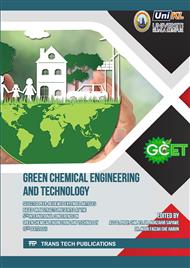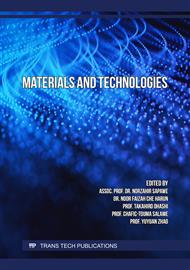[1]
M. K. Mondal, Removal of Pb(II) from industrial wastewater by using various natural materials- a review, Int. J. Sus. Dev. Plann. 3 (2008) 377–393.
DOI: 10.2495/sdp-v3-n4-377-393
Google Scholar
[2]
J. Anwar, U. Shafique,W. Uz-Zaman, M. Salman, A. Dar, S. Anwar, Removal of Pb(II) and Cd(II) from water by adsorption on peels of banana, Bioresour. Technol. 110 (2010) 1752–1755.
DOI: 10.1016/j.biortech.2009.10.021
Google Scholar
[3]
M. Arbabi, S. Hemati, M. Amiri, Removal of lead ions from industrial wastewater: a review of removal methods, Int. J. Epidemiol. Res. 2 (2015) 105-109.
Google Scholar
[4]
D. Xiao, W. Ding, J. Zhang, Y. Ge, Z. Wu, Z. Li, Fabrication of a versatile lignin-based nano-trap for heavy metal ion capture and bacterial inhibition, Chemical Engineering Journal, 358 (2019) 310–320.
DOI: 10.1016/j.cej.2018.10.037
Google Scholar
[5]
N. Ponomarev, O. Pastushok, E. Repo, B. Doshi, M. Sillanpää, Lignin-based magnesium hydroxide nanocomposite. Synthesis and aplication for the removal of potentially toxic metals from aqueous solution, ACS Appl. Nano Mater., 2 (2019) 5492–5503.
DOI: 10.1021/acsanm.9b01083
Google Scholar
[6]
Y. Duan, A. Freyburger, W. Kunz, C. Zollfrank, Lignin/chitin films and their adsorption characteristics for heavy metal ions, ACS Sustainable Chem. Eng., 6 (2018) 6965–6973.
DOI: 10.1021/acssuschemeng.8b00805
Google Scholar
[7]
Hermansyah, H. Cahyadi, Fatma, Miksusanti, G. Kasmiarti, A. T. Panagan, Delignification of lignocellulosic biomass sugarcane bagasse by using ozone as initial step to produce bioethanol, Pol. J. Environ. Stud., 30 (2019) 4405-4411.
DOI: 10.15244/pjoes/132263
Google Scholar
[8]
Directorate of food crops holticulture and estate crops statistics, Indonesian Sugar Cane Statistics, Statistics Indonesia, (2020).
Google Scholar
[9]
S. Al Arni, Extraction and isolation methods for lignin separation from sugarcane bagasse: A review, Industrial Crops and Products, 115 (2018) 330–339.
DOI: 10.1016/j.indcrop.2018.02.012
Google Scholar
[10]
Y. Kong, L. Wang, Y. Ge, H. Su, Z. Li, Lignin xanthate resin-bentonite clay composite as a highly effective and low-cost adsorbent for the removal of doxycycline hydrochloride antibiotic and mercury ions in water, The Journal of Hazardous Materials, 368 (2019) 33–41.
DOI: 10.1016/j.jhazmat.2019.01.026
Google Scholar
[11]
C. Y. Cao, J. Qu, F. Wei, H. Liu, W. G. Song, Superb adsorption capacity and mechanism of flowerlike magnesium oxide nanostructures for lead and cadmium ions, ACS Applied Materials & Interfaces, 4 (2012) 4283–4287.
DOI: 10.1021/am300972z
Google Scholar
[12]
A. Moubarik, N. Grimi, N. Boussetta, A. Pizzi, Isolation and characterization of lignin from moroccan sugar cane bagasse: production of lignin-phenol-formaldehyde wood adhesive, Industrial Crops and Products, 45 (2013) 296–302.
DOI: 10.1016/j.indcrop.2012.12.040
Google Scholar
[13]
H. Nadji, P. N. Diouf, A. Benaboura, Y. Bedard, B. Riedl, T. Stevanovic, Comparative study of lignins isolated from alfa grass (Stipa tenacissima L.), Bioresource Technology, 100 (2009) 3585–3592.
DOI: 10.1016/j.biortech.2009.01.074
Google Scholar
[14]
W. Boerjan, J. Ralph, M. Baucher, Lignin biosynthesis, Annual Review of Plant Biology, 54 (2003) 519–546.
DOI: 10.1146/annurev.arplant.54.031902.134938
Google Scholar
[15]
X. Zhao, L. Dai, D. Liu,Characterization and comparison of acetosolv and milox lignin isolated from crofton weed stem, J. Appl. Polym. Sci., 114 (2009) 1295–1302.
DOI: 10.1002/app.30604
Google Scholar
[16]
N. Ponomarev, E. Repo, V. Srivastava, M. Sillanpää, Green thermal-assisted synthesis and characterization of novel cellulose-Mg(OH)2 nanocomposite in PEG/NaOH solvent, Carbohydr. Polym., 176 (2017) 327–335.
DOI: 10.1016/j.carbpol.2017.08.101
Google Scholar
[17]
G.F. Coelho, A.C. Goncalves Jr, C. R. T. Tarley, J. Casarin, H. Nacke, M.A. Francziskowski, Removal of metal ions Cd(II), Pb(II), and Cr(III) from water by the cashew nut shell Anacardium occidentale L, Ecological Engineering, 73 (2014) 514-525.
DOI: 10.1016/j.ecoleng.2014.09.103
Google Scholar
[18]
R. Rajni, G. Usha, Mean centering ratio spectra as a new spectrophotometric method for the analysis of binary mixtures of vanadium and lead in water samples and alloys, Res. J. Chem. Sci., 2 (2012)22-29.
Google Scholar
[19]
K. Dai, X.Peng, P. Yang, M. Li, C. Tang, W. Zhuang, H. Ying, J. Wu, Highly selective and efficient lignin-magnesium for removing cationic dyes from wastewater. J. Environ. Chem. Eng., 8 (2020) 1-9.
DOI: 10.1016/j.jece.2020.104283
Google Scholar
[20]
K. F. Alsamarrai, Spectrophotometric assay of lead in human hair samples by using alizarin red (S) in Samarra area, J. of University of Anbar for Pure Science, 5 (2011) 3–10.
DOI: 10.37652/juaps.2011.44300
Google Scholar
[21]
Y. Ge, Q. Song, Z. Li, A Mannich base biosorbent derived from alkaline lignin for lead removal from aqueous solution, J. Ind. Eng. Chem., 23 (2015) 228–234.
DOI: 10.1016/j.jiec.2014.08.021
Google Scholar
[22]
L. M. Barros Júnior, G. R. Macedo, M. M. L. Duarte, E. P. Silva, A. K. C. L. Lobato, Biosorption of cadmium using the fungus Aspergillus niger, Braz. J. Chem. Eng., 20 (2003) 229–239.
DOI: 10.1590/s0104-66322003000300003
Google Scholar
[23]
R. P. Anjani and T. Koestiari, Determination of optimum mass and the time contact of the granular activated carbon adsorption used for adsorbent to removal heavy metal Pb(II) with competitor ion Na+.Unesa Journal of Chemistry, 3 (2014) 159–163.
Google Scholar
[24]
V. Nair, A. Panigrahy, R. Vinu, Development of novel chitosan-lignin composites for adsorption of dyes and metal ions from wastewater, Chemical Engineering Journal, 254 (2014) 491-502.
DOI: 10.1016/j.cej.2014.05.045
Google Scholar
[25]
S.W. Pratomo, F.W. Mahatmanti, and T. Sulistyaningsih, Pemanfaatan zeolit alam teraktivasi H3PO4 sebagai adsorben ion logam Cd(II) dalam larutan, Indonesian Journal of Chemical Science, 6 (2017) 161-167.
Google Scholar
[26]
Y. Ge, L. Qin, Z. Li, Lignin microspheres: An effective and recyclable naturan polymer-based adsorbent for lead ion removal, Mater. Des., 95 (2016) 141–147.
DOI: 10.1016/j.matdes.2016.01.102
Google Scholar
[27]
P. Saha and S. Chowdhury, Insight into Adsorption Thermodynamics, Thermodynamics, IntechOpen, 2011, page 474-489.
Google Scholar



